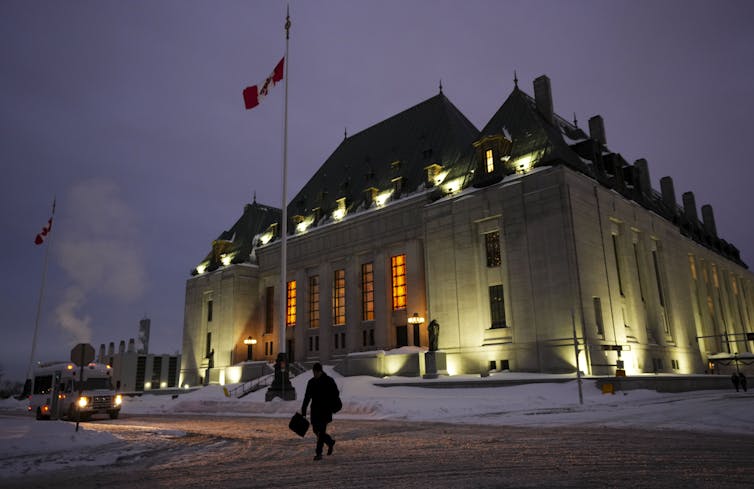On the heels of the latest United Nations Intergovernmental Panel on Climate Change report declaring a “rapidly closing window of opportunity” to secure a liveable future, the Supreme Court of Canada recently heard a case that could decide the future of Canadian climate policy.
Late last year, the Alberta Court of Appeal said the federal Impact Assessment Act — which seeks to minimize the environmental impacts of major economic projects — was unconstitutional because it intruded into provincial jurisdiction over natural resources development.
The federal government, on March 21 and 22, asked the Supreme Court of Canada to overturn the Alberta Court of Appeal’s opinion.
While we have to wait a year for its decision, the Supreme Court’s position is already clear — a majority of the court is poised to overturn the Alberta court’s opinion and uphold the Impact Assessment Act. The implications of the Supreme Court’s decision for Canadian climate policy, however, are more complicated.
The politics of climate change
The Impact Assessment Act became law in 2019. It replaced the controversial Canadian Environmental Assessment Act of 2012, which gutted the federal government’s ability to rigorously assess the adverse effects of economic projects on the environment.
But the Impact Assessment Act has proven to be no less controversial. Its opponents have dubbed it the “no more pipelines law” because of fears that the federal government will use it to block fossil fuel development. The express purposes of the law include fostering sustainability, mitigating climate change and incorporating Indigenous knowledge when assessing the impacts of major economic projects across Canada.
In 2020, Alberta’s provincial government asked its Court of Appeal to provide an opinion on the constitutionality of the federal law. A 4:1 majority found it unconstitutional.
The court accepted Alberta’s argument that the law would allow the federal government to conduct far-ranging inquiries into matters assigned exclusively to the provinces, including oil and gas.
This means that if a proposed oil project impacted even just one area of federal jurisdiction, say migratory birds, the federal government could assess all of the project’s impacts well beyond migratory birds, including broad and controversial issues like greenhouse gas emissions and sustainability.
The Alberta court acknowledged the existential threat of climate change. But it insisted the Impact Assessment Act is an equally important “existential threat” to the federal-provincial division of powers in Canada.
The hearing before the Supreme Court
The crux of the case before the Supreme Court now is thus a federal-provincial dispute over which level of government will determine Canada’s response to climate change. It’s a public policy dispute in the guise of complex constitutional law.
Judges on the court’s panel who are sympathetic to Alberta’s argument worry the federal government will use the law to regulate natural resources and greenhouse gas emissions, effectively overriding provincial control.
Even those judges who appear to favour the federal government worry the Impact Assessment Act is really just an end-run around the court’s recent decision on the federal government’s limited authority to regulate greenhouse gas emissions via carbon pricing.
Nevertheless, the majority of the Supreme Court’s panel of seven judges suggested a number of ways to interpret the law more narrowly. For example, the court suggested a requirement that the federal government’s power under the law be proportional to the project’s impacts on defined areas of federal jurisdiction. This will help preserve the balance of shared federal and provincial responsibility over the environment.
It’s all about politics
There’s no single correct legal answer to this case. There are compelling — but incomplete — legal arguments in favour of both sides. The decision will boil down to politics.
The Supreme Court will be loath to give either the federal government or Alberta a complete victory. Five of the court’s seven judges presiding over this case clearly see a constitutional path to salvaging the federal Impact Assessment Act by limiting its scope. This would preserve the provinces’ role in regulating the natural resources within their borders.
The Supreme Court has long held that both levels of government must protect the environment. Its preference is for federal-provincial co-operation, not conflict. As promising as that sounds, it isn’t enough. We need to first understand whether the Impact Assessment Act will help Canada become more sustainable or not, a question that did not come up once during the Supreme Court hearing.

THE CANADIAN PRESS/Sean Kilpatrick
While several environmental groups supported the federal act, many of those same organizations gave it a “C- grade” when it was introduced in 2018.
The law’s shortcomings included a failure to recognize Indigenous authority, the lack of any requirement to ensure that economic projects contribute to sustainability, a limited scope for assessing smaller projects and their cumulative effects and a lack of clear criteria and accountability for decision-making. It hasn’t improved since.
But a law’s ineffectiveness isn’t legally relevant to its constitutionality. A majority of the Supreme Court’s panel of judges will uphold a narrower interpretation of the federal government’s authority under the law to preserve shared federal-provincial jurisdiction over the environment.
Indeed, the court will remind Canadians that both levels of government are accountable for climate change, biodiversity conservation and sustainability. But its role does not require it to say anything about how our governments choose to meet their responsibility.
In the end, only Canadians themselves can truly compel the federal and provincial governments to act immediately and effectively before our window of opportunity to secure a liveable future closes. To do so, they must actively participate in climate politics, collectively organize and demand governments to lead the way towards ecological sustainability.



